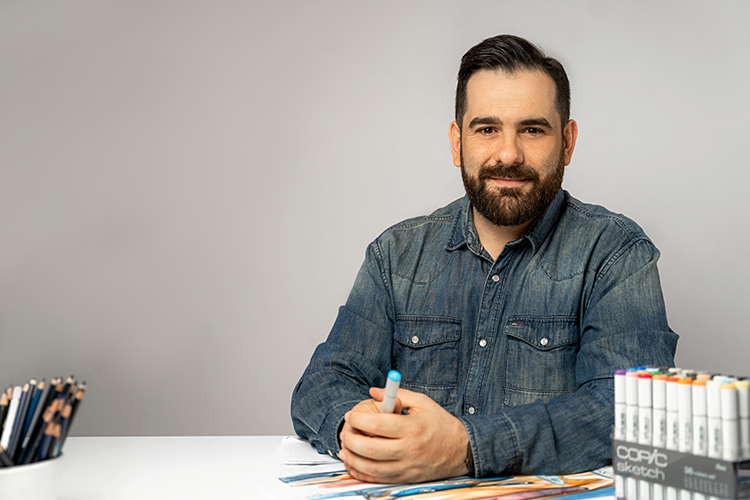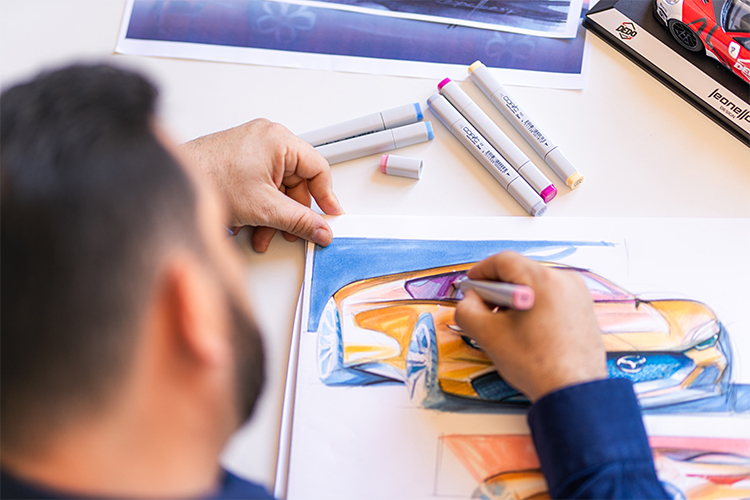- Category:
- All
- Design
- Illustration
- Manga
- Craft

Michele Leonello
With 20 years of experience in the automotive industry, Michele Leonello has worked as a designer on projects with some of the world's leading automotive companies, most notably Alfa Romeo and Maserati. He is also a lecturer at SPD Milan, a prominent design school in Milan, Italy.
Instagram/Website
Could you please introduce yourself to those not familiar with you?
My name is Michele Leonello, I am an Automotive and Racing Designer with 20 years of experience in the industry.
I am Italian and have had the honor of working for prestigious car companies, including Alfa Romeo and Maserati.
Today I have my own design studio with my collaborators, and I have been teaching at the Scuola Politecnica di Design in Milan for 11 years.
What was the reason that got you hooked on car design?
My father as well as my brother are policemen, I grew up as a child with the memory of my dad driving Alfa Romeo police cars. I was fascinated by the sound of the engines, the speed, and I started drawing for my dad and his colleagues. Then the main push came from my mom, who used to buy me car magazines at the newsagents, and I saw there for the first time drawings of Pininfarina made by Davide Arcangeli, my role model, or by designers like Cammardella, Corbi, d’Aprile.

Are there any artists that influenced your style?
Yes, there are a few that have influenced my growth and style a lot. As I said before, my biggest influence is Davide Arcangeli, who died prematurely, but left an indelible mark with the beauty of his designs and cars in the world of design. Then all the designers of the 80s and 90s at Pininfarina, as well as Anders Warming, the design director at Rolls Royce today, and also Chris Chapman design director of BMW Group Design works USA
When did you touch a Copic marker for the first time? What was your first impression?
Honestly, I met Copic when I worked in the advanced design department of Alfa Romeo. I was in a group of guys from all over the world, and for 15 months, every day we drew. We had no computers, no internet, no smartphones. We only had paper... a lot of paper, and Copic markers. We drew and colored all day long, creating ideas to propose to the Head of Design. There I learned about the quality and excellence of Copic. I saw many aspects that made them superior to all the competitors in the industry, such as the quality of the ink, the durability of each refill, the refillability, the ability to replace marker tips when they were worn, the wide color range, and so on.

Why do you still use Copic even now?
I am a person who works across the board, also using the most advanced technologies, but I am convinced that even today it is still essential to be able to create one's ideas on paper, using pencils and pens and color everything manually by hand.
Today it is too easy to delegate the task of coloring to software, you lose part of your art, your style. The satisfaction of realizing one’s own idea in a complete analogic way, is still the best primitive way to allow the brain to better understand the shapes, sections, surfaces, reflections that are fundamental parts in the development of a product design.
What Copic colors do you recommend for car design?
I think everyone, and I have friends who can make beautiful drawings using all kinds of colors in a car. I personally prefer to use cold grays for the shadows and warm grays for the car body.
What is your favorite part of the design process?
The creative research phase, the brainstorming phase, when we draw up sketches and then develop the idea in its initial phase. That's when you realize the potential of your brain and your creativity. Then of course all the pre-idea development phases are also interesting, but they are much longer and more stressful.

Is there anything you find difficult during the creation steps?
It is certainly difficult to know how to criticize one's own work. That is why it is important to be honest with oneself, to be able to evaluate one's own ideas, but also to be able to accept criticism and to understand that we often fail to see our mistakes right away or to realize that we can still improve or completely change our idea. I am fortunate to have excellent collaborators with whom I always try to have maximum freedom of expression and criticism.
Why did you take the teaching career?
It came about by pure chance at a particular time in my life. I come from a teaching family, my mother and two aunts are teachers, so it was in my blood to have this aptitude. I came up with a craft, where I mixed my knowledge as a former art school student with my experience in the car design world to be able to best teach this job.
We heard you worked for famous brands such as Alfa Romeo and Maserati.
What kind of needs do those brands have in terms of car design? How did you reflect them with your work?
I had the honor of working for these brands, with fantastic teams of colleagues and designers, with design leaders who prolong the reputation and heritage of brands. The biggest demands are to not misrepresent their style DNA but to always try to evolve with a continuity that allows their recognition on the road over time. The best method to understand brand values is to study in-depth the history, and the corporate culture, to get to know all those designers who have collaborated in the evolution of a brand and to capture that information that can transpose new ideas into your mind. Culture is the first thing that can enable a person to be able to create something that has a real soul.

What is the most important thing/skill for car design?
Being crazy and creative, having great hunger to want to learn and to be able to show the world your ideas and visions about the future of cars. It takes a lot of creativity, excellent quality in drawing and representation.
From the simplest sketch to the most detailed drawing, you need to mix creativity, art, design, research, development to get the WOW feeling.
Do you have any tips or tricks when using Copic?
Try mixing multiple colors to get more realistic and artistic effects. One of the greatest satisfactions is being able to mix colors to get color gradients. I love to do it very quickly when the color still remains slightly fresh on paper, so I can mix two or three markers at the same time to get a color graduation that helps me get a sense of the surface effect.
At last, could you give a message to those who aspire to become a car designer?
Be daring, draw a lot by hand, have fun coloring by hand, draw all your ideas on your sketchbooks or notebooks. Draw every day, every moment you can, and always practice. This will help you make that natural jump to then one day aspire to work in this field. The world of car design is changing, there is a need for new blood and creativity, always be fearless in your ideas, be crazy and be hungry.
All the photos in this interview were taken by Oksana Giugni.
Check out her Instagram account here.






